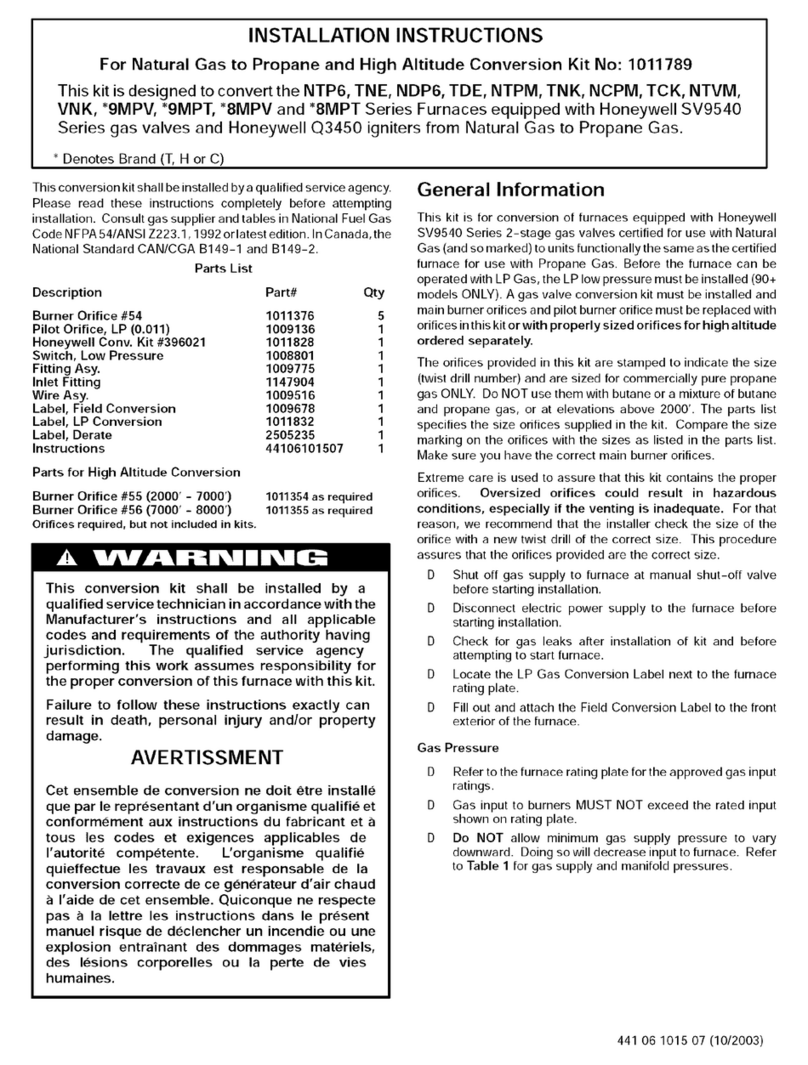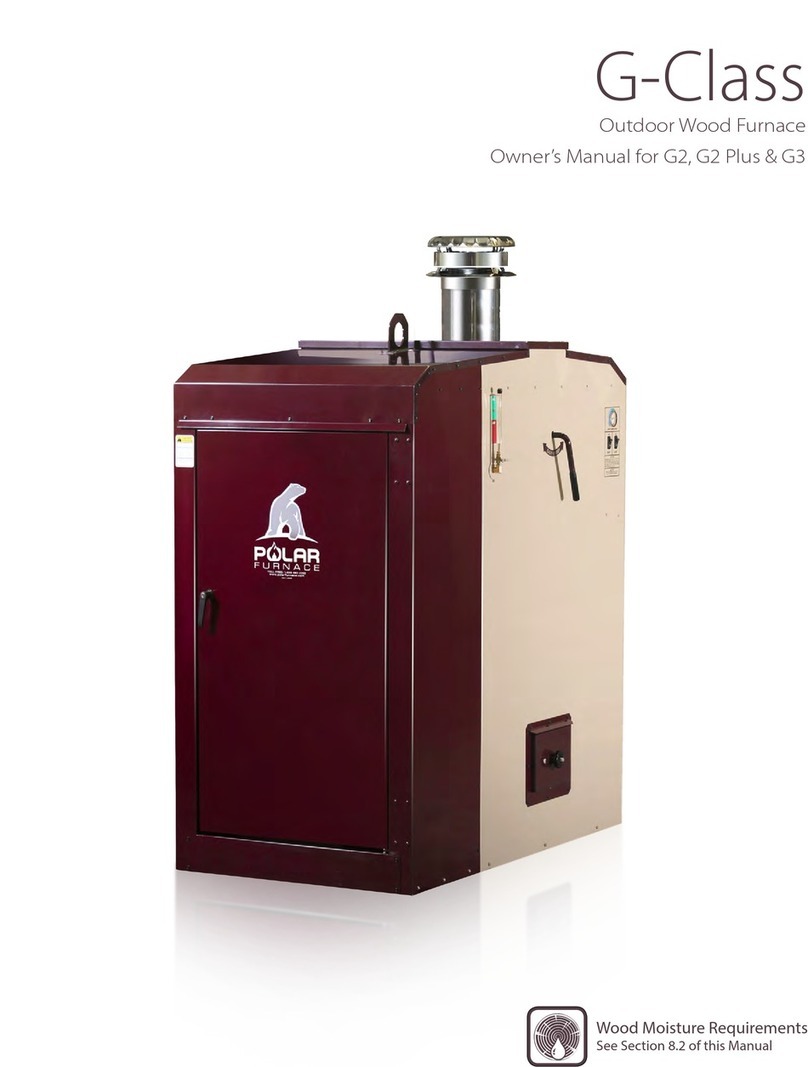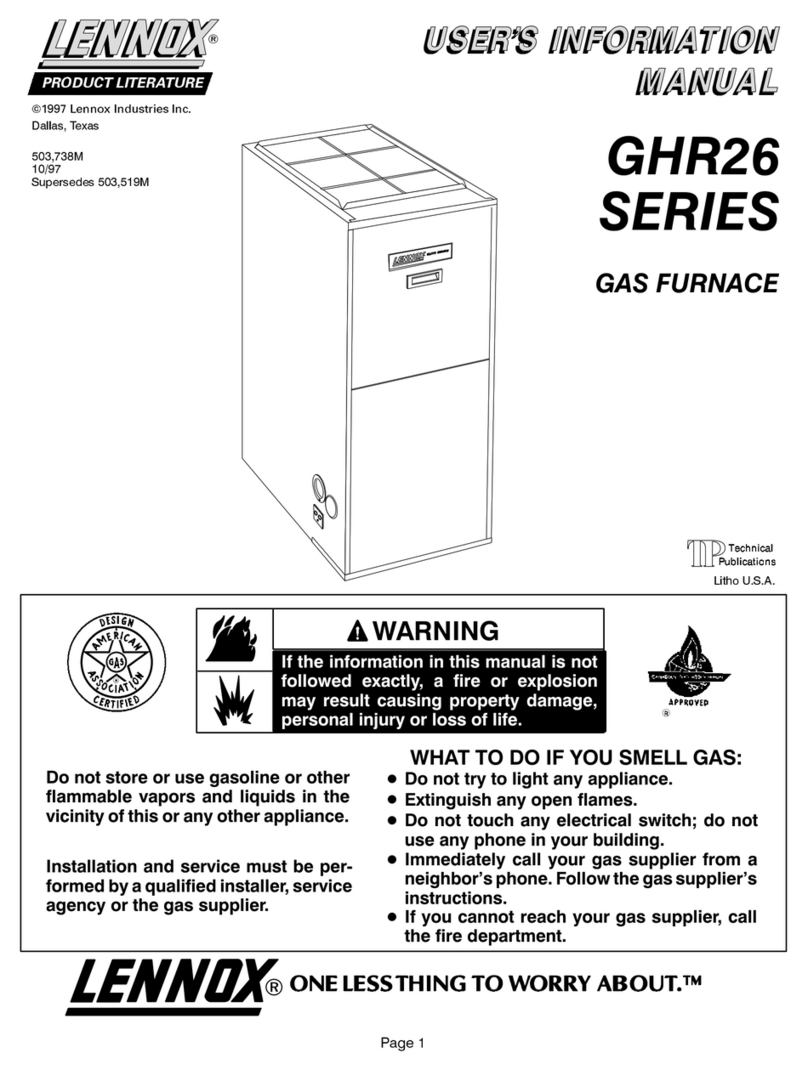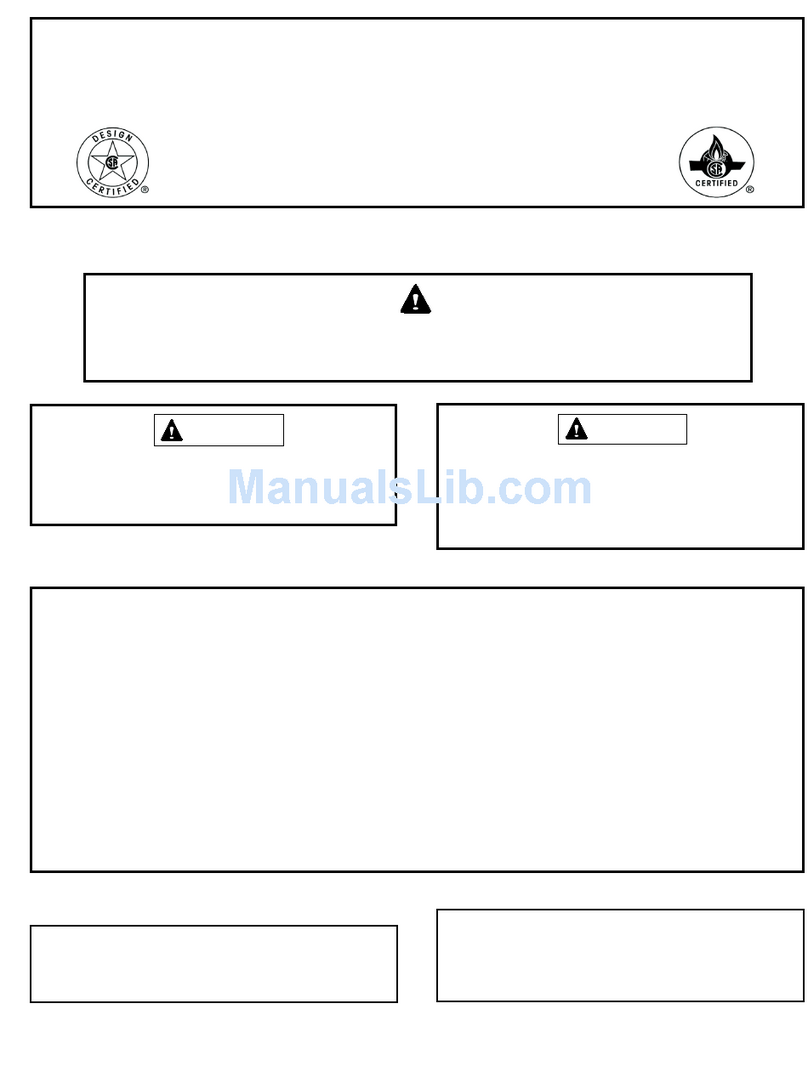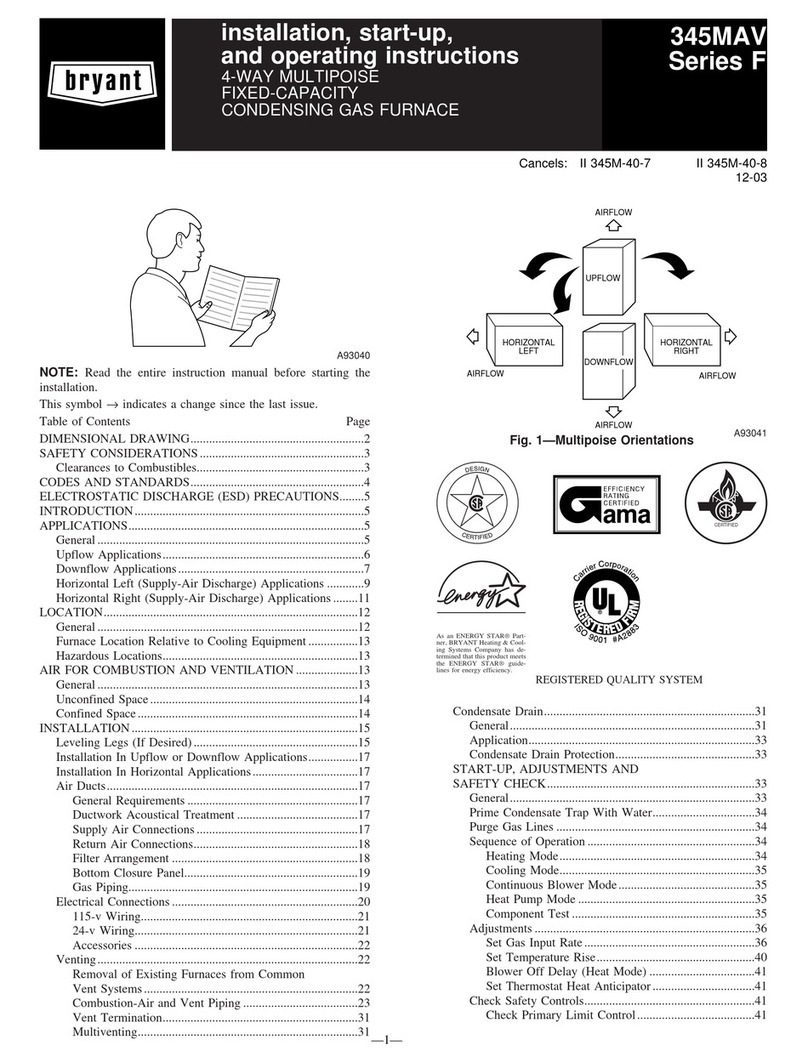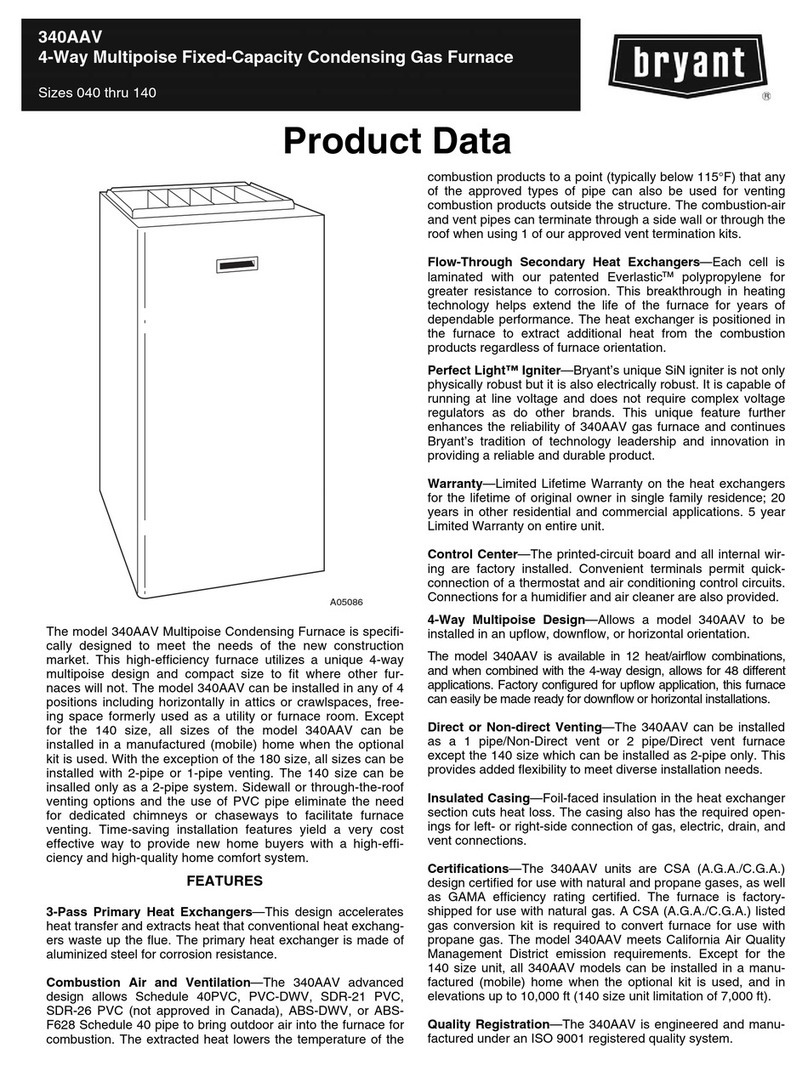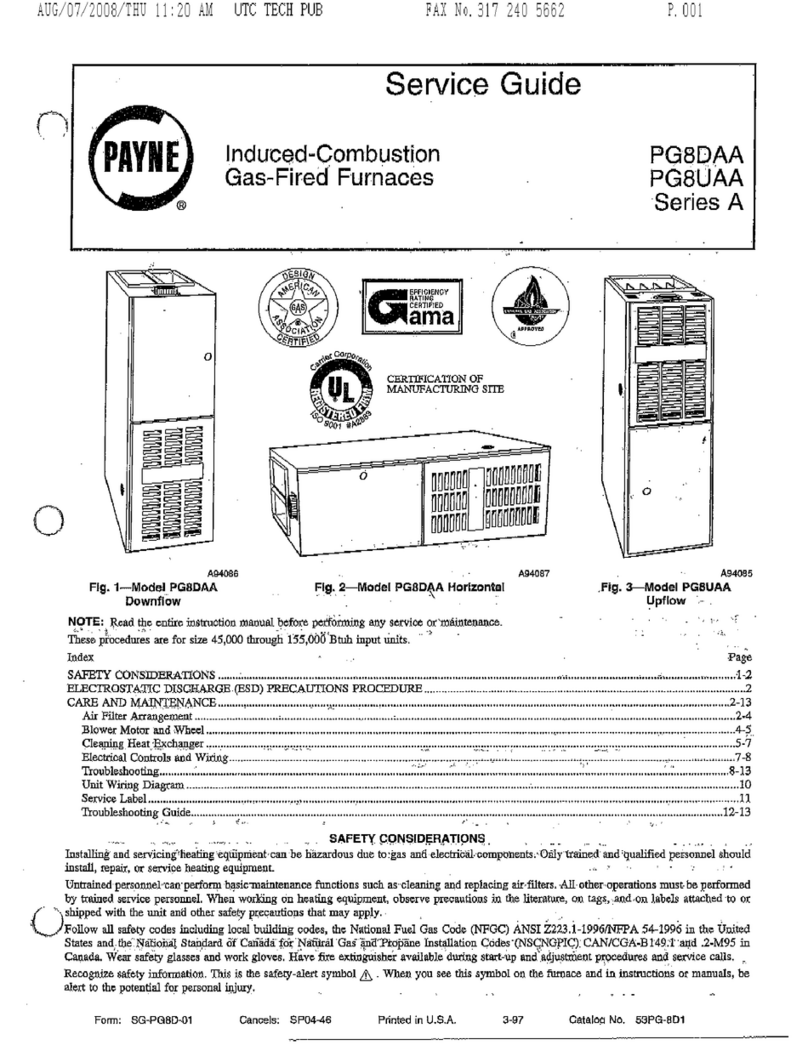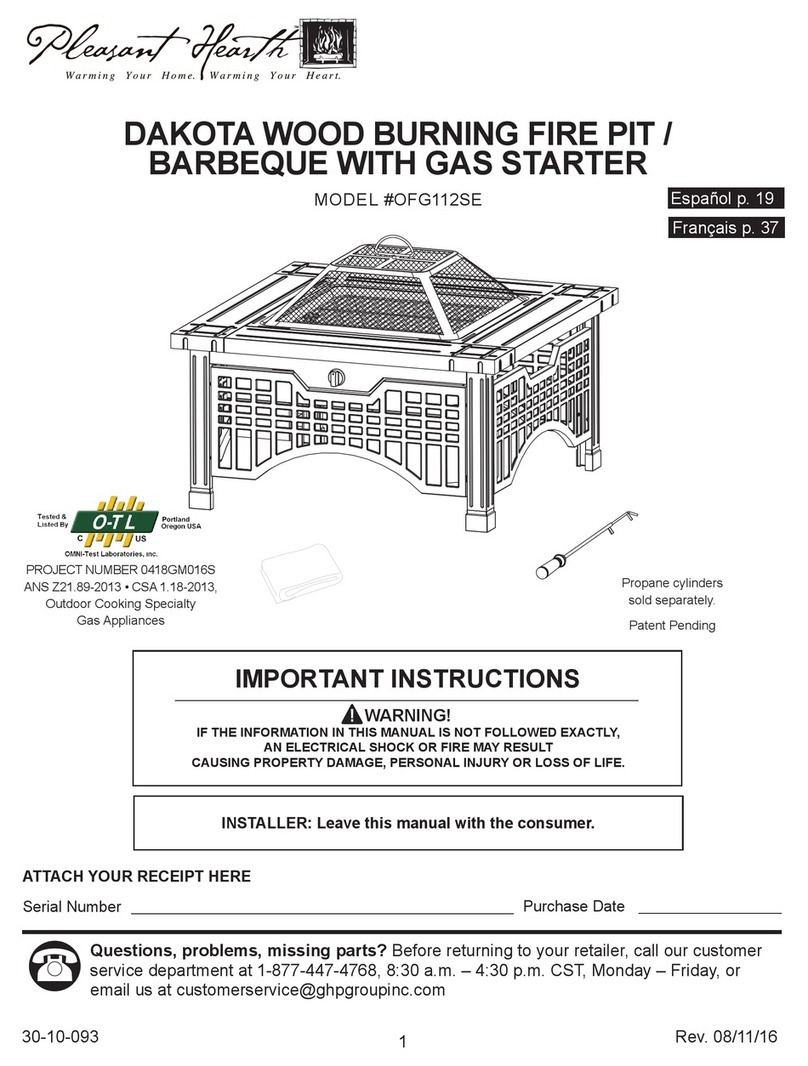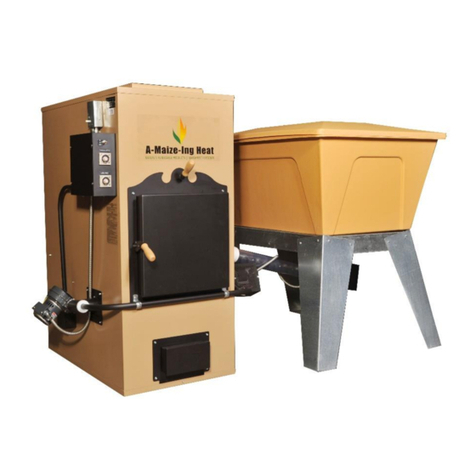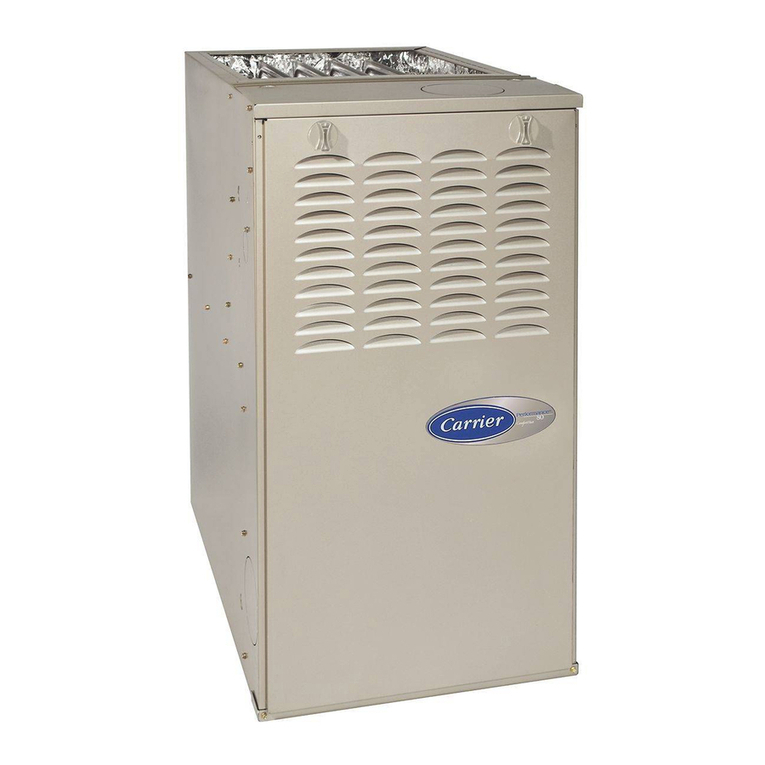Furrion FFG30FA User manual

30K/35K BTU RV GAS FURNACE
30K/35K BTU RV FOUR À GAZ
* Picture shown here is for reference only.
* L’image présentée ici est à titre de référence uniquement.

English
- 1 -
Thank you for purchasing this Furrion® product. Before operating your new appliance, please read these instructions carefully.
This instruction manual contains information for safe use, installation and maintenance of the appliance.
Please keep this instruction manual in a safe place for future reference. This will ensure safe use and reduce the risk of injury.
Be sure to pass on this manual to new owners of this appliance.
The manufacturer does not accept responsibility for any damages due to disregarding these instructions.
WARNING
FIRE OR EXPLOSION HAZARD
Failure to follow safety warnings exactly could result in serious injury, death, or
property damage.
●Do not store or use gasoline or other flammable vapors and liquids in the vicinity of
this or any other appliance.
●WHAT TO DO IF YOU SMELL GAS
–Evacuate all persons from the vehicle.
–Shut off the gas supply at the gas container or source.
–Do not touch any electrical switch, or use any phone or radio in the vehicle.
–Do not start the vehicle’s engine or electric generator.
–Contact the nearest gas supplier or qualified service technician.
–If you cannot reach a gas supplier, contact the nearest fire department.
–Do not turn on the gas supply until the gas leak(s) has been repaired.
●Installation and service must be performed by a qualified installer, service agency, or
the gas supplier.

CONTENTS
EXPLANATION OF SYMBOLS....................................................................................................................................................
IMPORTANT SAFETY INSTRUCTIONS....................................................................................................................................
BEFORE INSTALLING..................................................................................................................................................................
Identifying the Furnace Location ...................................................................................................................................................................................... 4
Determining an Installation Type and Cutout Sizing................................................................................................................................................. 5
Ducting.......................................................................................................................................................................................................................................... 6
INSTALLATION..............................................................................................................................................................................
A. Install with Furrion Standard Access Door Panel ................................................................................................................................................. 9
B. Install without Access Panel........................................................................................................................................................................................... 9
C. Install with Customer Supplied Outer Panel ........................................................................................................................................................... 10
Vent Assembly Installation................................................................................................................................................................................................... 10
Duct Connection....................................................................................................................................................................................................................... 11
Gas Connection........................................................................................................................................................................................................................ 11
Electrical Connection............................................................................................................................................................................................................. 12
Thermostat Installation.......................................................................................................................................................................................................... 12
OPERATION...................................................................................................................................................................................
Turning ON the Furnace ........................................................................................................................................................................................................ 13
Turning Off The Furnace....................................................................................................................................................................................................... 13
SERVICE AND MAINTENANCE..................................................................................................................................................
Monthly Inspection and Maintenance............................................................................................................................................................................. 14
Annual Maintenance............................................................................................................................................................................................................... 15
Remove/Re-install the Furnace......................................................................................................................................................................................... 15
TROUBLESHOOTING ..................................................................................................................................................................
WIRING DIAGRAM........................................................................................................................................................................
SPECIFICATION ...........................................................................................................................................................................
English
- 2 -

EXPLANATION OF SYMBOLS
This manual has safety information and instructions to help
you eliminate or reduce the risk of accidents and injuries.
Always respect all safety warnings identified with these
symbols. A signal word will identify safety messages and
property damage messages, and will indicate the degree or
level of hazard seriousness.
DANGER
Indicates an imminently hazardous situation which, if not
avoided, will result in death or serious injury.
WARNING
Indicates a potentially hazardous situation which, if not
avoided, could result in death or serious injury.
CAUTION
Indicates a potentially hazardous situation which, if not
avoided, may result in minor or moderate personal injury, or
property damage.
IMPORTANT SAFETY INSTRUCTIONS
●This furnace must be installed, repaired, and serviced by
a qualified service technician.
●Do not use the furnace cabinet area as a storage
compartment.
●Do not modify this furnace in any way. Modification can
be extremely hazardous.
●Keep the insulating material, clothing, or flammable
material away from the furnace.
●Do not use this furnace if any part has been under water.
A flood-damaged furnace is extremely dangerous.
Attempts to use the furnace can result in fire or explosion.
A qualified service agency should be contacted to
inspect the furnace and to replace all gas controls,
control system parts, electrical parts that have been wet
or the furnace if deemed necessary.
●The sheet metal edges are sharp, take care when
handling or touching the edges.
●Protect the furnace electrical components from water.
●Keep the compartment closed when operating the
furnace.
●Do not install screens over the air intake or exhaust vents
for any reason.
●Do not use the furnace for temporary heating of buildings
or structures under construction.
●Do not use petroleum or citrus-type cleaner on plastic
parts, as damage may occur.
●Do not restrict the ducting or block furnace outlet
registers and return-air grills.
●Do not install air boosters in the duct system.
●Do not touch exterior exhaust grills when the furnace is
operating.
●Supervise young children who are in the same room as
the furnace.
●Protect building materials from degrading from vent
assembly gas exhaust.
●Use only Furrion approved replacement parts and
components.
WARNING
FIRE OR EXPLOSION HAZARD
●Ensure that all intended components are attached to
the furnace after installation. The furnace should never
be used without all intended components attached
correctly.
●Do not store gasoline, oil, gasoline-soaked rags, or
other flammable vapors and liquids inside storage
compartment(s).
●Before refueling or parking near a gasoline pump,
ensure that all LP gas appliances (vented to the
outside of the RV) are shut OFF. Otherwise, fumes from
gasoline pumps could come into contact with an LP
gas appliance burner flame and ignite.
●Turn OFF the LP gas supply at the gas tank.
●Keep the furnace area clear and free of combustible
materials, gasoline, and other flammable vapors and
liquids.
●Keep the furnace area free and clear from insulating
material, as insulating materials might be combustible.
Examine the furnace area when the furnace is installed
or when insulation is added.
●Use only with the type of gas approved for the furnace.
Refer to the furnace rating plate.
●Do not overfill LP gas tanks. LP tanks must be filled
by a qualified gas supplier only. Follow the tank
manufacturer’s operating instructions located on the
tank.
●Immediately shut down the furnace and call a service
agency if the furnace cycles erratically or delays on
ignition.
●Shut OFF the gas valve to the furnace before shutting
off the electrical supply if the gas supply fails to shut off,
or if overheating should occur.
English

WARNING
CARBON MONOXIDE HAZARD
●This furnace can produce carbon monoxide, which has
no odor and can be life-threatening. Keep the burner
and vent assembly system clean from any obstructions.
●Doors must be properly sealed and the draft cap and
assemblies must be adjusted and sealed correctly to
prevent carbon monoxide from entering the RV.
●Do not block the exhaust system of the furnace.
●Combustion products must be properly vented to the
atmosphere and all combustion air supplied to the
burner must be drawn from the outside atmosphere.
WARNING
ELECTRICAL SHOCK HAZARD
●This furnace is designed for 12VDC negative ground
only. Never attempt to alter it for a positive ground
system or connect it directly to a 115 VAC power.
●Do not use a battery charger to supply power to the
furnace, even when testing.
●Use only Furrion approved replacement parts and
components.
BEFORE INSTALLING
Identifying the Furnace Location
WARNING
●Only install the furnace in a location specified in these
instructions.
●Aways provide adequate combustion and ventilation air
to the furnace space, as specified in these instructions.
All combustion products must be discharged outdoors.
Only connect this furnace to an approved vent system
as specified in these instructions.
●Always install the furnace to operate within the
furnace’s intended temperature-rise range, with a duct
system that has an external static pressure within the
allowable range. Refer to the furnace rating plate.
●Do not install the furnace near tilt-out rooms, slide-outs,
doors (refer to local codes for clearances), or in an area
where wires, pipes, or other objects will interfere with
the installation or operation of the furnace.
●Do not install the furnace in an area that is less than 12"
above a water heater (unless a heat shield is installed
above the water heater).
●Do not install the furnace directly on combustible
flooring that restricts return air. Examples of
combustible flooring include carpet, tile, soft material
(like vinyl), or other combustible materials other than
wood flooring.
●Do not install the furnace where the clearance to
combustibles cannot be maintained. Excessive
exposure to contaminated combustion air will result in
safety and performance-related problems.
NOTE: The furnace must be accessible for repairs after
installed.
Installation Position and Clearances
●Install the furnace of the RV where the location is out of
the way of wires, pipes, etc, which might interfere with the
installation. Adhere to the minimum clearances defined in
“Minimum Clearance to Combustibles” section.
●When installing the furnace on carpeting, tile, or other
combustible material areas, other than wood flooring, a
metal or wood panel extending the full width and depth
of the furnace is required to be installed under the unit. If
preferred, you may cut the full width and depth plus the
minimum clearances to combustibles around the furnace.
●Identify the clearances required between the furnace
and the surrounding materials to allow for proper airflow.
See the “Minimum Clearance to Combustibles” and
the “Proper Return-Air Inlet Clearance” sections for
detailed clearances.
Installation Type
You can install the furnace either horizontally or vertically.
Determine the installation type you will use.
For horizontal installation:
WARNING
CARBON MONOXIDE POISONING HAZARD
Failure to follow instructions could result in severe
personal injury or death due to carbon monoxide
poisoning, if combustion products infiltrate into the
living space.
Rear Gas
Connection
Front Gas
Connection
English
- 4 -

Mounting the Furnace - Horzontial
Front Gas Only
Rear Gas Only
#8 x 1½” screw
#8 x 1½” screw
For vertical installation:
Rear Gas
Connection
Front Gas
Connection
Mounting the Furnace - Vertical
#10 x ¾” screw
#10 x ¾” screw
#8 x 1½” screw
It is important that adequate return air be provided to assure
normal heating and operation of the furnace. Failure to
provide the minimum return air will cause erratic furnace
cycling.
Return air should be isolated from affecting any free air
supply needed for other combustion appliances. i.e. ranges,
cooktops, refrigerators.
NOTERVs that have a wall of separation to a cargo area
(Toy Box) to transport internal combustion engine vehicles
must not have return air openings from this area.
Refer to the chart below for minimum return air requirements.
Return Air Requirements
Minimum Free (unobstructed) Area 55 in
NOTE: Return air must be from within the living area of the
RV.
Minimum Clearance to Combustibles
The minimum clearances allowed between the surface of the
furnace and combustible objects (board, wall, floor, etc) are
shown in the table.
Clearance to Combustibles*
Top 1"
Left Side 1"
Right Side 1"
Bottom 1"
Floor 0"
Back 0"
Exhaust and Intake Tube
*Combustibles are carpet, vinyl, tile, plywood, or similar
building materials.
NOTE: 0” means in contact with the furnace surface. The
clearance from ducts to combustible materials is ¼". (Except
UL rated duct certified for 0" clearance to combustibles)
Determining an Installation Type and
Cutout Sizing
Determine the appropriate installation type and prepare the
cutout dimensions per the appropriate figure below.
Installation Type and Cutout Dimensions
Installation Type Access Panel Cutout Dim.
ACustomer supplied panel
See graphBFurrion access panel
CNo panel
Horizontal Installation
Vertical Installation
Horizontal Installation Vertical Installation
Horizontal Installation Vertical Installation
Furnace Support Surface Furnace Support Surface
Furnace Support Surface Furnace Support Surface
Furnace Support Surface Furnace Support Surface
Furnace Support Surface Furnace Support Surface
Furnace Support Surface Furnace Support Surface
Furnace Support Surface Furnace Support Surface
RV Exterior Wall
Cutout
8 ¼" (±⁄")
210 mm (±3mm)
RV Exterior Wall
Cutout
RV Exterior Wall
Cutout Center Line
Cutout
RV Exterior Wall Cutout
RV Exterior Wall
Cutout
8 ¼" (±⁄")
210 mm (±3mm)
18 ¼" (±⁄")
463 mm (±3mm)
RV Exterior Wall Cutout
17 ¾" min.
451 mm
8" min.
203 mm
8" min.
203 mm
17 ¾" min.
451 mm
Furnace Bottom Furnace Bottom
Furnace Bottom
Furnace Bottom
Furnace Bottom Furnace Bottom
18 ¼" (±⁄")
463 mm (±3mm)
3 3/8"
86 mm
6 13/16"
173 mm
2 1/16"
52 mm
Ø 2 ¾"
70 mm 2 1/16"
52 mm
Ø 2 ¾"
70 mm
3 ⅜"
86 mm
English
- 5 -

Horizontal Installation
Vertical Installation
Horizontal Installation Vertical Installation
Horizontal Installation Vertical Installation
Furnace Support Surface Furnace Support Surface
Furnace Support Surface Furnace Support Surface
Furnace Support Surface Furnace Support Surface
Furnace Support Surface Furnace Support Surface
Furnace Support Surface Furnace Support Surface
Furnace Support Surface Furnace Support Surface
RV Exterior Wall
Cutout
8 ¼" (±⁄")
210 mm (±3mm)
RV Exterior Wall
Cutout
RV Exterior Wall
Cutout Center Line
Cutout
RV Exterior Wall Cutout
RV Exterior Wall
Cutout
8 ¼" (±⁄")
210 mm (±3mm)
18 ¼" (±⁄")
463 mm (±3mm)
RV Exterior Wall Cutout
17 ¾" min.
451 mm
8" min.
203 mm
8" min.
203 mm
17 ¾" min.
451 mm
Furnace Bottom Furnace Bottom
Furnace Bottom
Furnace Bottom
Furnace Bottom Furnace Bottom
18 ¼" (±⁄")
463 mm (±3mm)
3 3/8"
86 mm
6 13/16"
173 mm
2 1/16"
52 mm
Ø 2 ¾"
70 mm 2 1/16"
52 mm
Ø 2 ¾"
70 mm
3 ⅜"
86 mm
For this type of installation, there is no door cutout required
on the RV exterior wall but 2 round holes for the exhaust vent
and air intake.
Access must be provided from the front, for removal of the
Furnace during servicing.
Horizontal Installation Vertical Installation
Horizontal Installation Vertical Installation
Horizontal Installation
Vertical Installation
Furnace Support Surface Furnace Support Surface
Furnace Support Surface Furnace Support Surface
Furnace Support Surface Furnace Support Surface
Furnace Support Surface Furnace Support Surface
Furnace Support Surface Furnace Support Surface
Furnace Support Surface Furnace Support Surface
RV Exterior Wall
Cutout
8 ¼" (±⁄")
210 mm (±3mm)
RV Exterior Wall
Cutout
RV Exterior Wall
Cutout Center Line
Cutout
RV Exterior Wall Cutout
RV Exterior Wall
Cutout
8 ¼" (±⁄")
210 mm (±3mm)
18 ¼" (±⁄")
463 mm (±3mm)
RV Exterior Wall Cutout
17 ¾" min.
451 mm
8" min.
203 mm
8" min.
203 mm
17 ¾" min.
451 mm
Furnace Bottom Furnace Bottom
Furnace BottomFurnace Bottom
Furnace Bottom
Furnace Bottom
18 ¼" (±⁄")
463 mm (±3mm)
3 3/8"
86 mm
6 13/16"
173 mm
2 1/16"
52 mm
Ø 2 ¾"
70 mm
2 1/16"
52 mm
Ø 2 ¾"
70 mm
3 ⅜"
86 mm
Horizontal Installation Vertical Installation
Horizontal Installation Vertical Installation
Horizontal Installation
Vertical Installation
Furnace Support Surface Furnace Support Surface
Furnace Support Surface Furnace Support Surface
Furnace Support Surface Furnace Support Surface
Furnace Support Surface Furnace Support Surface
Furnace Support Surface Furnace Support Surface
Furnace Support Surface Furnace Support Surface
RV Exterior Wall
Cutout
8 ¼" (±⁄")
210 mm (±3mm)
RV Exterior Wall
Cutout
RV Exterior Wall
Cutout Center Line
Cutout
RV Exterior Wall Cutout
RV Exterior Wall
Cutout
8 ¼" (±⁄")
210 mm (±3mm)
18 ¼" (±⁄")
463 mm (±3mm)
RV Exterior Wall Cutout
17 ¾" min.
451 mm
8" min.
203 mm
8" min.
203 mm
17 ¾" min.
451 mm
Furnace Bottom Furnace Bottom
Furnace BottomFurnace Bottom
Furnace Bottom
Furnace Bottom
18 ¼" (±⁄")
463 mm (±3mm)
3 3/8"
86 mm
6 13/16"
173 mm
2 1/16"
52 mm
Ø 2 ¾"
70 mm
2 1/16"
52 mm
Ø 2 ¾"
70 mm
3 ⅜"
86 mm
Horizontal Installation Vertical Installation
Horizontal Installation
Vertical Installation
Horizontal Installation Vertical Installation
Furnace Support Surface Furnace Support Surface
Furnace Support Surface Furnace Support Surface
Furnace Support Surface Furnace Support Surface
Furnace Support Surface Furnace Support Surface
Furnace Support Surface Furnace Support Surface
Furnace Support Surface Furnace Support Surface
RV Exterior Wall
Cutout
8 ¼" (±⁄")
210 mm (±3mm)
RV Exterior Wall
Cutout
RV Exterior Wall
Cutout Center Line
Cutout
RV Exterior Wall Cutout
RV Exterior Wall
Cutout
8 ¼" (±⁄")
210 mm (±3mm)
18 ¼" (±⁄")
463 mm (±3mm)
RV Exterior Wall Cutout
17 ¾" min.
451 mm
8" min.
203 mm
8" min.
203 mm
17 ¾" min.
451 mm
Furnace Bottom
Furnace Bottom
Furnace BottomFurnace Bottom
Furnace Bottom Furnace Bottom
18 ¼" (±⁄")
463 mm (±3mm)
3 3/8"
86 mm
6 13/16"
173 mm
2 1/16"
52 mm
Ø 2 ¾"
70 mm 2 1/16"
52 mm
Ø 2 ¾"
70 mm
3 ⅜"
86 mm
Horizontal Installation Vertical Installation
Horizontal Installation
Vertical Installation
Horizontal Installation Vertical Installation
Furnace Support Surface Furnace Support Surface
Furnace Support Surface Furnace Support Surface
Furnace Support Surface Furnace Support Surface
Furnace Support Surface Furnace Support Surface
Furnace Support Surface Furnace Support Surface
Furnace Support Surface Furnace Support Surface
RV Exterior Wall
Cutout
8 ¼" (±⁄")
210 mm (±3mm)
RV Exterior Wall
Cutout
RV Exterior Wall
Cutout Center Line
Cutout
RV Exterior Wall Cutout
RV Exterior Wall
Cutout
8 ¼" (±⁄")
210 mm (±3mm)
18 ¼" (±⁄")
463 mm (±3mm)
RV Exterior Wall Cutout
17 ¾" min.
451 mm
8" min.
203 mm
8" min.
203 mm
17 ¾" min.
451 mm
Furnace Bottom
Furnace Bottom
Furnace BottomFurnace Bottom
Furnace Bottom Furnace Bottom
18 ¼" (±⁄")
463 mm (±3mm)
3 3/8"
86 mm
6 13/16"
173 mm
2 1/16"
52 mm
Ø 2 ¾"
70 mm 2 1/16"
52 mm
Ø 2 ¾"
70 mm
3 ⅜"
86 mm
Ducting
WARNING
It is important to size the ducting appropriately based on
the instruction below, otherwise damage to the furnace can
occur.
●Ducts 2” or less in diameter should not be factored in the
duct sizing.
●Ducts terminating in dead air spaces with no means for
return air re-circulation should not be counted in the
ducting area.
●Do not install any register within 18” to the return air
opening unless on a wall at 90 degrees to the return air
opening. Never blow the outlet air direct towards the
return air opening.
●Do not install any air booster in the duct system. Such
devices could cause erratic cycle behavior.
Keep all return-air passages clear to allow the furnace to
function properly. Do not block the return airflow path with
ducting.
English
- 6 -

To ensure the proper operation of the furnace, the duct
requirements listed below must be followed completely,
and the minimum open duct areas must be maintained
throughout the entire duct system, including the registers.
Model 4” Round Ducts
(ducts 1 - 7)
Rectangular
Duct - 14” x 4”
(Top & Bottom -
ducts 8 - 9)
Rectangular
(duct 10)
FFG30AF
FFG30AR
36 in
(3 ducts min.) 56 in52 in
FFG35AF
FFG35AR
48 in
(4 ducts min.) 56 in52 in
NOTE: Remove the duct adapter plate before using the 9”
with the 2 round duct knockouts left closed when not used.
Duct adapter plate
Duct 1
Duct 2 Duct 3
Duct 4
Duct 5
Duct 7
Duct 6
Duct 8
Duct 9
Duct 10
Your furnace can be installed as a bottom-discharge system
in either a horizontal or a vertical position as appropriate.
1. Cut an opening for the floor discharge system through
the RV floor.
2. Remove the bottom side discharge plate.
3. Seal the furnace to a hard ducting system using a UL-
approved foil tape, or choose a gasket (not provided) that
is rated for 300°F temperature minimum.
4. Position the furnace into the floor opening and seal
around for airtight.
RV Wall
Horizontal Floor Ducting - Top View
Floor Ducting Area
14"
(356 mm)
4"
(102 mm)
English

5 13/16"
(148 mm)
RV Wall
Vertical Floor Ducting - Top View
9"
(229 mm)
Floor Ducting Area
Installing the Duct Collars
1. Remove the knockout plate(s) from the desired outlet(s).
Keep all other knockout plates in place if not used.
Knockout Plate
2. Install the duct adapter (provided) by inserting the flange
over the casing hole and turning the duct adapter 90° to
lock the tab into the casing slot.
3. Securely attach ducting to the duct adapter.
NOTE: If an unexpected knockout is removed accidentally,
consult Furrion or Furrion authorized dealer to purchase the
cover plates.
INSTALLATION
Installation of this appliance must be made in accordance
with the written instructions provided in this manual.
●This furnace shall be installed so the electrical
components are protected from water.
●This furnace is designed and certified for propane gas
use only. Do not attempt to convert to natural gas.
●Gas supply pressure for purposes of input adjustment:
minimum 11" W.C., maximum 13" W.C.
●The maximum wall thickness for installing the furnace is
2". Do not exceed the maximum wall thickness.
●The tubes supplied with the furnace accommodates an
installation 0 - 2". If greater than 2", then special tubes
must be purchased.
The installation must conform with local codes and
regulations. In the absence of such codes, refer to the latest
edition of:
In the U.S.A.:
1. Standard for Recreational Vehicles NFPA 1192.
2. National Fuel Gas Code ANSI Z223.1/NFPA 54.
3. Furnace must be electrically grounded in accordance
with the latest edition of the National Electrical Code
NFPA 70.
In Canada::
1. Standard CSA Z240.0.2-08 Recreational Vehicles.
2. CSA Standard Z240.6.2-08 C22.2 NO 148-08 Electrical
Requirements for Recreational Vehicles.
3. Standard Z240.4.2-08 Installation Requirements for
Propane Appliances and Equipment in Recreational
Vehicles.
4. CAN/CGA-B149 Installation Codes.
5. Any applicable local codes and regulations.
WARNING
Do not install screens over the vent for any reason. Screens
will become restricted and cause unsafe furnace operation.
Accessories are being marketed for RV products which we
do not recommend. For your safety, only factory authorized
parts are to be used on your furnace.
WARNING
Do not alter, cut or otherwise modify the vent tubes
as supplied with the furnace. Doing so could result in
inadequate intake of air combustion or improper exhaust
venting.
There are three (3) methods described below for installing
the furnace.
English
- 8 -

A. Install with Furrion Standard Access
Door Panel
WARNING
Ensure the vehicle wall is strong enough to hold the furnace
access door in place and seal properly. When necessary,
build a wood or metal frame around the opening to provide
adequate strength for securing the door.
Before installing, determine the desired “X” (ranges from 0 -
2") dimension as shown below.
HORIZONTAL INSTALLATION VERTICAL INSTALLATION
HORIZONTAL INSTALLATION VERTICAL INSTALLATION
HORIZONTAL INSTALLATION
VERTICAL INSTALLATION
HORIZONTAL INSTALLATION VERTICAL INSTALLATION
RV Floor
X
Outer Panel
RV Floor
RV Wall
Exhaust Vent and
Air Intake Tubes
RV Floor
RV Wall
Removable
Panel
Exhaust Vent and
Air Intake Tubes
RV Exterior
Wall
RV Floor
RV Wall
Exhaust Vent and
Air Intake Tubes
RV Exterior
Wall
RV Floor
RV Wall
X
Exhaust Vent and
Air Intake Tubes
Outer Panel
Exhaust Vent Tube
RV Floor
RV Wall
Air Intake Tube
Outer Panel
Removable Panel
RV Wall
X
Exhaust Vent Tube
Air Intake Tube
RV Exterior Wall
RV Floor
RV Wall
Exhaust Vent Tube
Air Intake Tube
RV Floor
RV Wall
X
Exhaust Vent Tube
Air Intake Tube
RV Exterior Wall
Furrion Access
Door Panel
Furrion Access
Door Panel
Outer Panel
HORIZONTAL INSTALLATION VERTICAL INSTALLATION
RV Exterior
Wall
RV Floor
RV Wall
Exhaust Vent and
Air Intake Tubes
RV Floor
RV Wall
Exhaust Vent Tube
Air Intake Tube
RV Exterior Wall
X
X
HORIZONTAL INSTALLATION VERTICAL INSTALLATION
HORIZONTAL INSTALLATION VERTICAL INSTALLATION
HORIZONTAL INSTALLATION
VERTICAL INSTALLATION
HORIZONTAL INSTALLATION VERTICAL INSTALLATION
RV Floor
X
Outer Panel
RV Floor
RV Wall
Exhaust Vent and
Air Intake Tubes
RV Floor
RV Wall
Removable
Panel
Exhaust Vent and
Air Intake Tubes
RV Exterior
Wall
RV Floor
RV Wall
Exhaust Vent and
Air Intake Tubes
RV Exterior
Wall
RV Floor
RV Wall
X
Exhaust Vent and
Air Intake Tubes
Outer Panel
Exhaust Vent Tube
RV Floor
RV Wall
Air Intake Tube
Outer Panel
Removable Panel
RV Wall
X
Exhaust Vent Tube
Air Intake Tube
RV Exterior Wall
RV Floor
RV Wall
Exhaust Vent Tube
Air Intake Tube
RV Floor
RV Wall
X
Exhaust Vent Tube
Air Intake Tube
RV Exterior Wall
Furrion Access
Door Panel
Furrion Access
Door Panel
Outer Panel
HORIZONTAL INSTALLATION VERTICAL INSTALLATION
RV Exterior
Wall
RV Floor
RV Wall
Exhaust Vent and
Air Intake Tubes
RV Floor
RV Wall
Exhaust Vent Tube
Air Intake Tube
RV Exterior Wall
X
X
Once the furnace installation opening is prepared as per
the dimensions outlined in “
” and the “X” dimension is determined:
1. Apply butyl or foam gasket around the entire back flange
of the door frame bezel.
2. Slide the furnace into the opening. Position the furnace
within “X” (max. 2”) of the Furrion access door panel.
3. For horizontal installation, fix the furnace to the RV
floor using two (2) #8 x 1” min. screws (not provided).
For vertical installation, fix the furnace to the RV floor
using four (4) #10 x ¾” min. screws (2 pcs each side, not
provided) and one (1) #8 x ½” min. screw to the wall (if
possible).
4. Align and place the door frame and access door over
the opening and secure them to the RV exterior wall with
sixteen (16) #8 x 1” screws.
5. Install the exhaust vent and air intake tubes. See “Vent
Assembly Installation” section.
RV Wall
Door Frame
B. Install without Access Panel
Before installing, determine the desired “X” (ranges from 0 -
2”) dimension as shown below.
HORIZONTAL INSTALLATION VERTICAL INSTALLATION
HORIZONTAL INSTALLATION VERTICAL INSTALLATION
HORIZONTAL INSTALLATION VERTICAL INSTALLATION
HORIZONTAL INSTALLATION
VERTICAL INSTALLATION
RV Floor
X
Outer Panel
RV Floor
RV Wall
Exhaust Vent and
Air Intake Tubes
RV Floor
RV Wall
Removable
Panel
Exhaust Vent and
Air Intake Tubes
RV Exterior
Wall
RV Floor
RV Wall
Exhaust Vent and
Air Intake Tubes
RV Exterior
Wall
RV Floor
RV Wall
X
Exhaust Vent and
Air Intake Tubes
Outer Panel
Exhaust Vent Tube
RV Floor
RV Wall
Air Intake Tube
Outer Panel
Removable Panel
RV Wall
X
Exhaust Vent Tube
Air Intake Tube
RV Exterior Wall
RV Floor
RV Wall
Exhaust Vent Tube
Air Intake Tube
RV Floor
RV Wall
X
Exhaust Vent Tube
Air Intake Tube
RV Exterior Wall
Furrion Access
Door Panel
Furrion Access
Door Panel
Outer Panel
HORIZONTAL INSTALLATION VERTICAL INSTALLATION
RV Exterior
Wall
RV Floor
RV Wall
Exhaust Vent and
Air Intake Tubes
RV Floor
RV Wall
Exhaust Vent Tube
Air Intake Tube
RV Exterior Wall
X
X
HORIZONTAL INSTALLATION VERTICAL INSTALLATION
HORIZONTAL INSTALLATION VERTICAL INSTALLATION
HORIZONTAL INSTALLATION VERTICAL INSTALLATION
HORIZONTAL INSTALLATION
VERTICAL INSTALLATION
RV Floor
X
Outer Panel
RV Floor
RV Wall
Exhaust Vent and
Air Intake Tubes
RV Floor
RV Wall
Removable
Panel
Exhaust Vent and
Air Intake Tubes
RV Exterior
Wall
RV Floor
RV Wall
Exhaust Vent and
Air Intake Tubes
RV Exterior
Wall
RV Floor
RV Wall
X
Exhaust Vent and
Air Intake Tubes
Outer Panel
Exhaust Vent Tube
RV Floor
RV Wall
Air Intake Tube
Outer Panel
Removable Panel
RV Wall
X
Exhaust Vent Tube
Air Intake Tube
RV Exterior Wall
RV Floor
RV Wall
Exhaust Vent Tube
Air Intake Tube
RV Floor
RV Wall
X
Exhaust Vent Tube
Air Intake Tube
RV Exterior Wall
Furrion Access
Door Panel
Furrion Access
Door Panel
Outer Panel
HORIZONTAL INSTALLATION VERTICAL INSTALLATION
RV Exterior
Wall
RV Floor
RV Wall
Exhaust Vent and
Air Intake Tubes
RV Floor
RV Wall
Exhaust Vent Tube
Air Intake Tube
RV Exterior Wall
X
X
Once the furnace installation opening is prepared as per the
dimensions outlined in “”and
the “X” dimension is determined:
1. Position the furnace within “X” (max. 2”) of the RV exterior
wall. Make sure the exhaust vent tube and air intake tube
are located into the cutout holes.
2. For horizontal installation, fix the furnace to the RV
floor using two (2) #8 x 1” min. screws (not provided).
For vertical installation, fix the furnace to the RV floor
using four (4) #10 x ¾” min. screws (2 pcs each side, not
provided) and one (1) #8 x ½” min. screw to the wall (if
possible).
English
- 9 -

3. Install the exhaust vent and air intake tubes. See “Vent
Assembly Installation” section.
RV Wall
C. Install with Customer Supplied Outer
Panel
NOTE: Make sure a proper size outer panel is used. The
panel should cover all over around the cutout, a little larger
than the cutout.
Before installing, determine the desired “X” (ranges from 0 -
2”) dimension as shown below.
HORIZONTAL INSTALLATION VERTICAL INSTALLATION
HORIZONTAL INSTALLATION
VERTICAL INSTALLATION
HORIZONTAL INSTALLATION VERTICAL INSTALLATION
HORIZONTAL INSTALLATION VERTICAL INSTALLATION
RV Floor
X
Outer Panel
RV Floor
RV Wall
Exhaust Vent and
Air Intake Tubes
RV Floor
RV Wall
Removable
Panel
Exhaust Vent and
Air Intake Tubes
RV Exterior
Wall
RV Floor
RV Wall
Exhaust Vent and
Air Intake Tubes
RV Exterior
Wall
RV Floor
RV Wall
X
Exhaust Vent and
Air Intake Tubes
Outer Panel
Exhaust Vent Tube
RV Floor
RV Wall
Air Intake Tube
Outer Panel
Removable Panel
RV Wall
X
Exhaust Vent Tube
Air Intake Tube
RV Exterior Wall
RV Floor
RV Wall
Exhaust Vent Tube
Air Intake Tube
RV Floor
RV Wall
X
Exhaust Vent Tube
Air Intake Tube
RV Exterior Wall
Furrion Access
Door Panel
Furrion Access
Door Panel
Outer Panel
HORIZONTAL INSTALLATION VERTICAL INSTALLATION
RV Exterior
Wall
RV Floor
RV Wall
Exhaust Vent and
Air Intake Tubes
RV Floor
RV Wall
Exhaust Vent Tube
Air Intake Tube
RV Exterior Wall
X
X
HORIZONTAL INSTALLATION VERTICAL INSTALLATION
HORIZONTAL INSTALLATION
VERTICAL INSTALLATION
HORIZONTAL INSTALLATION VERTICAL INSTALLATION
HORIZONTAL INSTALLATION VERTICAL INSTALLATION
RV Floor
X
Outer Panel
RV Floor
RV Wall
Exhaust Vent and
Air Intake Tubes
RV Floor
RV Wall
Removable
Panel
Exhaust Vent and
Air Intake Tubes
RV Exterior
Wall
RV Floor
RV Wall
Exhaust Vent and
Air Intake Tubes
RV Exterior
Wall
RV Floor
RV Wall
X
Exhaust Vent and
Air Intake Tubes
Outer Panel
Exhaust Vent Tube
RV Floor
RV Wall
Air Intake Tube
Outer Panel
Removable Panel
RV Wall
X
Exhaust Vent Tube
Air Intake Tube
RV Exterior Wall
RV Floor
RV Wall
Exhaust Vent Tube
Air Intake Tube
RV Floor
RV Wall
X
Exhaust Vent Tube
Air Intake Tube
RV Exterior Wall
Furrion Access
Door Panel
Furrion Access
Door Panel
Outer Panel
HORIZONTAL INSTALLATION VERTICAL INSTALLATION
RV Exterior
Wall
RV Floor
RV Wall
Exhaust Vent and
Air Intake Tubes
RV Floor
RV Wall
Exhaust Vent Tube
Air Intake Tube
RV Exterior Wall
X
X
Once the furnace installation opening is prepared as per the
dimensions outlined in “
” and the “X” dimension is determined:
1. Position the furnace within “X” (max. 2”) to the customer
supplied outer panel.
2. Follow the installation instructions that is supplied with
the outer panel to install the outer panel over the furnace.
NOTE: It is the installer’s responsibility of making sure
the outer panel is sealed and secured appropriately
3. For horizontal installation, fix the furnace to the RV
floor using two (2) #8 x 1” min. screws (not provided).
For vertical installation, fix the furnace to the RV floor
using four (4) #10 x ¾” min. screws (2 pcs each side, not
provided) and one (1) #8 x ½” min. screw to the wall (if
possible).
4. Install the exhaust vent and air intake tubes. See “Vent
Assembly Installation” section.
Outer Panel
RV Wall
Vent Assembly Installation
WARNING
Do not alter the vent assembly supplied with this furnace.
Any modifications will result in improper installation and
may cause unsafe furnace operation.
WARNING
●Do not install the air intake to draw combustion air from
the living area instead of the outside atmosphere.
●Always vent the exhaust gases outside the RV. Never
vent inside.
Install the vent outlet in the same atmospheric pressure
zone as the combustion air intake. It is advised to use the
additional vent shield provided when the vent outlet is
installed vertically.
1. Apply butyl tape to the RV exterior wall/outer panel/
access door behind the vent cap.
2. Apply sealant or butyl tape to the back flange around
perimeter of the vent cap assembly.
3. Pass the air intake tube through the air intake hole and
push to slide it over the furnace intake tube. Overlap the
air intake tube over the furnace intake by a minimum of
1/2".
4. Pass the vent cap and exhaust tube through the exhaust
hole and push it over the furnace exhaust tube. Overlap
the vent cap exhaust tube over the furnace exhaust by a
minimum of 11/4".
5. Place the vent cap assembly over the exhaust vent and
air intake holes and fix with 6 screws provided.
English
- 10 -

RV Wall
Vent Cap and Exhaust Tube
Air IntakeTube
Duct Connection
When running the duct system, avoid making a lot of turns
to the system. The straighter the duct system, the better
performance the furnace will have.
1. Seal the hard ducting to the furnace and the floor
completely. Some additional flex ducts may be required
when the hard duct depth is over 1½”.
2. Provide a minimum of 1/4” distance from the ducting to
any combustible constructions. Only use metal based
ductwork.
3. Do not install any floor registers below the thermostat.
4. Stretch out all the ducts and run them directly to the
outlets. Maintain a minimum number of angles and avoid
sharp bends, deep sags, or crushed ducting.
Ducting not Recommended
5. Attach and secure the 4” flexible duct to the duct adapter.
NOTE: Ensure the duct connections at the furnace are
tight. Loose connections will result in overheating of
the furnace components and reduce the heated air flow
through the duct system.
6. Run duct(s) to the desired location(s) inside the RV.
Maintain a minimum of 1/4” clearance to any combustible
constructions where ducts pass through, such as RV
cabinetry.
NOTE: UL-listed duct materials can be 0” clearance.
7. Secure the duct(s) to the register(s).
Heat Register
RV Wall
Ducting
Gas Connection
NOTE: Do not apply more than ½ PSI to the appliance when
pressure testing for leaks.
●Always perform an adequate pressure test on the piping
system before connecting the gas to the furnace.
●Adjust the piping system to maintain the minimum gas
supply pressure listed on the rating plate.
●To maintain proper pressure at the furnace, an easily
the gas connection for checking pressure.
WARNING
Always use two wrenches to hold and tighten gas
connections, to prevent leaks from forming.
NOTE: For rear gas connection models, an elbow joint (not
included) is required for proper connection.
Elbow for Reference
gas line hookup. You may require a manual shut-off valve to
connect the external gas line to the furnace cabinet.
1. Connect the gas supply line to the furnace at the
manifold. Hold the flare fitting at the manifold when
connecting or loosening the gas supply line.
NOTE: Never use thread sealant on flared connectors.
2. After the furnace has been connected to the gas supply,
check and test all connections for leaks. See “Gas Leak
Test ” section.
WARNING
Gas leaks may occur in your system and result in a
dangerous situation. Always perform a leak test for
possible leaks according to the manufacturer’s instructions
after installation and before any operation.
WARNING
FIRE OR EXPLOSION HAZARD
●Extinguish all open flames.
●Never leak test when smoking. Never check for leaks
with an open flame.
●Do not use the furnace until all joints have been leak-
tested and does not leak.
If a pressure leak test can not be performed, it is acceptable
to use the following method to check for leaks.
English
- 11 -

1. Apply a commercially available gas leak detection liquid
(soapy water) to all gas connections. If bubbles are
presented, there is a gas leak.
2. If a gas leak is detected, tighten the loose joint, or replace
the faulty part with a replacement part recommended by
Furrion or Furrion authorized retailer.
Electrical Connection
WARNING
ELECTRICAL SHOCK HAZARD
●Do not “Hi-Pot” the furnace unless the electronic
ignition system (circuit board) has been disconnected.
●The Furnace must be installed so that electrical
components are protected from water and other
installation debris.
●The direct high voltage spark ignition of the furnace
generates a radio frequency that may cause
interference with other microprocessor-based
equipment. Locate any equipment at least five feet from
the Furnace location.
CAUTION
This furnace is designed for negative ground 12 volt D.C.
system only. Do not attempt to alter the furnace for a
positive ground system or connect the furnace directly
to 115 volts A.C. Damage to furnace component parts will
occur.
The furnace must be electrically grounded in accordance
with local codes, or in the absence of local codes, with
the National Electrical Code, ANSI/NFPA 70, and/or the
Canadian Electrical Code, CSA C22.1, Part 1, if an external
electrical source is utilized.
●Connect to a dedicated 15amp - 20amp circuit.
●Ensure all wiring gauge to the furnace is heavy enough
to maintain a minimum voltage drop and provide
enough power for start-up surge. A 12 gauge wire is
recommended.
●The power supply connection ports are located at the top
of the furnace. If any original wire that is supplied with the
furnace must be replaced, replace it with the type 105°C
resistant or its equivalent.
●The wires are color-coded, red for positive (+) and yellow
for negative (-). Always observe the polarity while wiring
the furnace to ensure correct air delivery. See the “Wiring
Diagram” section.
●If the power supplied to the furnace is from a converter,
it is recommended to wire the converter system and the
battery in parallel. Which will serve two purposes:
–Provide a constant voltage supply to the furnace.
–Filter any AC spikes or volt surges.
Thermostat Installation
The thermostat used with the furnace must have no voltage
output when there is no signal for heating or in the “OFF”
setting.
WARNING
Do not install the thermostat near the areas where there
are other heating loads, such as direct sunlight, heat-
producing appliances (television, radio, wall lamp, etc.)
or air conditioner output registers. Failure to follow these
instructions may result in serious injury or death.
Read before proceeding:
1. Purchase a thermostat rated for 12 VDC, 1 amp minimum.
Disconnect all electrical power to the furnace.
2. Locate a dry area with good air circulation away from
any other heat resources. When possible, install the
thermostat approximately 4½ feet above the floor on an
interior wall. When installing on an exterior wall, use a 3/4”
spacer between the thermostat and wall for proper room
air sensing.
3. Wire the thermostat to the blue wire and blue-white
striped wire (blue-white striped wire is the power to the
thermostat) on the right side of the furnace. See the
“Wiring Diagram” section.
Follow the manufacturer’s installation instructions provided
with the thermostat.
English
- 12 -

OPERATION
WARNING
FIRE OR EXPLOSION HAZARD
●Do not try to operate the furnace when the vehicle is in
motion or being towed.
●For proper and safe operation to the furnace, do not
to block or obstruct air openings on the furnace, air
openings to the area in which the furnace is installed,
and the spacings around the furnace.
●This furnace has an ignition device that will ignite the
burner automatically. It does not have a pilot. Do not try
to light the burner by hand.
●Because some gas is heavier than air and will settle
near the floor, before operating, smell next to the floor
area and around the furnace area for gas, and check
the fittings with leak test solutions. Do not proceed if
a gas leak is presented. Follow the instructions in the
warning box on the first page.
●Always turn the gas control valve only by hand. Never
use tools. Do not attempt to repair the gas control
valve if it does not turn by hand. Always call a qualified
service technician.
●A flood-damaged furnace is extremely dangerous,
do not use it if any part has been under water. Always
contact a qualified service agency to inspect the
furnace and replace the gas controls, control system
parts, electrical parts that got wet, or the whole furnace
when necessary.
WARNING
Should the gas supply fail to shut off or if overheating
occurs, shut off the gas valve to the furnace before shutting
off the electrical supply.
This furnace is equipped with a power switch. Gas will not
flow to the burner, and the furnace will not operate with the
power switch in the OFF position.
Power Switch
NOTE: During the initial firing of the furnace. A burn-off
of excess paint and oils remains from the manufacturing
process may cause “smoking” for 5-10 minutes.
Turning ON the Furnace
1. STOP! Read users information manual supplied with the
furnace.
2. Turn the manual valve (if so equipped) or the valve at the
outside LP tank to the OFF position. Do not force.
3. Set the thermostat above room temperature to begin
blower operation. Allow blower to run for five (5) minutes
for combustion chamber purge cycle.
4. After five (5) minutes. Set the thermostat to the OFF
position.
5. Open the manual valve (do not force). Correct operating
characteristics depend on this valve being fully open.
Never attempt to operate with valve partially closed.
6. Set the thermostat on desired temperature.
7. Allow thirty (30) seconds for main burner to light.
8. If burner does not light, set the thermostat to OFF, wait
until blower stops. And repeat steps 1 through 6.
9. If after three (3) attempts with no ignition, go to shut
down and contact your dealer or a local recreational
vehicle service agency. Do not continue to cycle furnace through
thermostat in an attempt to light it.
1. Set the thermostat to the OFF position.
2. Turn manual valve at the LP tank (if equipped) to the OFF position.
Do NOT force the valve.
3.
performed.
English

SERVICE AND MAINTENANCE
You, as the owner/user, should inspect the furnace monthly
during the heating season for the presence of soot on the
vent. Operating the furnace under this condition could lead
to serious property damage, personal injury, or loss of life. If
soot is observed on the vent, immediately shut the furnace
down and contact a qualified service agency.
●Never attempt to repair the furnace yourself. Contact a
qualified service technician.
●Keep the furnace, control compartments, burners, and
circulating air passageways clean and unobstructed.
More frequent cleaning may be required from excessive
lint from carpeting, bedding materials, pet hair, etc.
●Do not use petroleum or a citrus-type cleaner on plastic
parts, as damage may occur.
WARNING
ELECTRICAL SHOCK, FIRE, OR EXPLOSION
HAZARD
Failure to follow the safety warnings exactly could
result in dangerous operation, serious injury, death,
or property damage.
Improper servicing could result in dangerous
operation, serious injury, death, or property damage.
–Before servicing, disconnect all electrical power
to the Furnace.
–When servicing the controls, label all wires prior
to disconnecting for servicing and servicing
controls. Reconnect the wires correctly.
–Verify proper operation after servicing.
WARNING
If the user of this appliance fails to maintain it in the
condition in which it was shipped from the factory or if
the appliance is not used solely for its intended purpose
or if appliance is not maintained in accordance with the
instructions in this manual, then the risk of a fire and/or the
production of carbon monoxide exists which can cause
personal injury, property damage or loss of life.
Annual Inspections
Your furnace should be inspected by a qualified person
yearly before turning the furnace on. Particular attention
should be given to the following items.
●Ensure the vents properly exhaust into the atmosphere
and that the vent assembly is positioned tightly against
the outer door.
●Inspect the vent for obstructions or the presence of soot.
If soot is present, immediately shut off the furnace and
contact your dealer or a qualified service technician.
●Inspect the furnace exhaust tubes for blockage, overlap,
holes, or soot.
●Keep all tubes clean and free of obstructions.
Air Intake Tube
Exhaust Tube
Chamber
Inspect the chamber and vent system for holes or excessive
corrosion. Inspect combustion chamber for restrictions
in exhaust or intake. It is imperative that the flow of intake
combustion air and the flow of exhaust gases being expelled
to the outside atmosphere not be obstructed . Any soot or
loose debris should be blown out using compressed air.
Chamber
Check the base on which furnace is mounted, and ensure it is
physically sound, avoid of any sagging, deterioration, and etc.
Sagging/Deteriorated
0RXQWLQJ%DVH
Inspect the furnace, venting, ducting, and gas piping for
obvious signs of deterioration. Correct any defects.
English
- 14 -

Vent Assembly
Observe the main burner flame to assure it is burning with a
hard blue flame with well defined burner ports (See Figure
8) If flame appears yellow or burner has a lazy flame, shut
furnace down. It is possible that burner needs cleaning or
replaced. If excessive rust and corrosion are present on
burner surface, the burner must be thoroughly cleaned or
replaced. The burner may be cleaned using a steel wire brush
and blown clean using high compression air.
NOTE: To properly observe burner operation, the furnace
must be removed.
SHARP BLUE FLAME
CORRECT FLAME INCORRECT FLAME
YELLOW FLAME
Annual Maintenance
A qualified person should perform the following preventative
maintenance and safety checks annually.
AIR WHEEL Clean and clear any obstructions.
ORIFICE
INSPECTION
Inspect the orifice annually.
BURNER Requires no adjustment, inspect
annually. Clean burner with a wire
brush to remove debris and corrosion
build up.
CONTROL
COMPARTMENT
Remove dirt and lint.
DUCTING Clean and clear obstructions.
Reconnect any ducts that have
become loose.
GAS PRESSURE
TEST
Test the entire piping system. Test the
gas connections for leaks with a leak
test solution.
GAS SUPPLY
SYSTEM
Perform a pressure drop test according
to current ANSI standards.
GASKETS Inspect all gaskets for tight seals.
GENERAL Check physical support system for
sagging cracks, gaps, etc.
MOTOR Requires no oiling. Permanently sealed
and lubricated. Inspect annually.
RETURN AIR Clean and clear obstructions.
VENTING Check position of exhaust tube and
Furnace chamber tube.
VOLTAGE Check power with applicable power
sources (generator, battery, and
converter).
WIRE
CONNECTIONS
Check for loose, disconnected, or worn
insulation areas.
NOTE: The motor is permanently lubricated and requires no
oiling.
Remove/Re-install the Furnace
1. Disconnect the power to furnace, and ensure gas supply
at the LP gas tank is OFF.
2. Remove the vent cap assembly.
3. If installed with customer supplied outer panel, remove
the removable panel (if used) and the outer panel. If
installed with Furrion standard access door panel,
remove the access door.
4. Disconnect the power supply at furnace.
5. Remove the gas supply line at the furnace.
6. Remove the screws that holding the furnace to the RV
wall.
7. Pull to remove the furnace out from the wall opening.
1. Reverse the steps to re-install the furnace after
completed the servicing.
2. Re-connect the power supply to the furnace.
English
- 15 -

TROUBLESHOOTING
Problem Remedy
Furnace will not
light – Blower does
not turn on.
Reset the power to the furnace.
Check that your gas valves are ON, and that the tanks are not empty.
Check the main fuse panel for a blown fuse.
The Furnace-installed breaker switch may be tripped or OFF – Contact a trained RV service provider.
The 12 VDC power is low; check the RV system voltage.
The Furnace may be in lockout. Reset the Furnace by switching the thermostat to OFF for 10 seconds,
then switch the thermostat to ON. If air is in the propane line, repeat this process up to three times.
Check the intake and vents to make sure they are not blocked or obstructed.
Air is in the LP line. Purge the air by turning on other appliances (like a cooktop) that are further
downstream from the LP tanks.
The thermostat is not set to Heat or a high enough temperature. Adjust the thermostat.
Furnace shuts off
before it reaches
the desired
temperature.
Check to make sure all the vents are open and not covered.
Check the air intake to make sure it is not blocked or obstructed.
English
- 16 -

WIRING DIAGRAM
BK
BK
R
R
GND
GND
Y G
FAN-
Relay
IGNITION
CONTROL
SAIL SWITCH
LIMIT
SWITCH
VALVE
Rocker
Switch
FAN+
DC+ DC-
MOTOR
THERMOSTAT
THERMOSTAT
+ 12V DC
- 12V DC
BL BL
BL
BL
BK
BK
BR
BR
W
W
R
CODE COLOR ALL WIRES ARE 22 AWG UNLESS OTHERWISE SPECIFIED. NOTE: IF THE ORIGINAL
WIRES THAT COME WITH ELECTRICAL APPLIANCES NEED TO BE REPLACED, THE
TEMPERATURE RESISTANCE OF WIRE MATERIALS SHOULD NOT BE LOWER THAN THE
NOMINAL VALUE OF THE ORIGINAL WIRES.
RRED
BL BLUE
BK BLACK
WWHITE
BR BROWN
Y G YELLOW GREEN
18AWG UL1015 105°C 14AWG UL1015 105°C
22AWG UL3122 200°C
English

SPECIFICATION
Technical Specifications
Optional Power Gas power
BTU/HR See appliance Rating Tag.
Fuel / Power Propane
Inlet Pressure 11” WC Min to 13” WC Max
Power Input 12V DC See appliance Rating Tag
English
- 18 -

Français
CCD-0006025 Rév: 27-02-23 - 1 -
Merci d'avoir acheté ce produit Furrion®. Avant d’utiliser votre nouvel appareil, veuillez lire attentivement les présentes consignes. Le présent manuel
d’instructions contient des consignes permettant une utilisation, une installation et un entretien de l’appareil en toute sécurité.
sécurité et réduit tout risque de blessures. Veillez à transmettre le présent manuel à tout nouveau propriétaire de cet appareil.
Le fabricant décline toute responsabilité pour tout dommage résultant du non-respect des présentes consignes.
AVERTISSEMENT
RISQUE D'INCENDIE OU D'EXPLOSION
Le non-respect exact des consignes de sécurité peut entraîner des blessures graves, la mort ou
des dommages matériels.
●Ne rangez pas ou n'utilisez pas d'essence ou d'autres vapeurs et liquides inammables à
proximité de cet appareil ou de tout autre appareil.
●QUE FAIRE SI VOUS SENTEZ UNE ODEUR DE GAZ
–Évacuez toutes les personnes du véhicule.
–Coupez l'alimentation en gaz au niveau du réservoir ou de la source de gaz.
–Ne touchez à aucun interrupteur électrique et n'utilisez aucun téléphone ou radio dans le
véhicule.
–Ne démarrez pas le moteur ou le générateur électrique du véhicule.
–Contactez le fournisseur de gaz ou le technicien de maintenance qualié le plus proche pour
les réparations.
–Si vous ne parvenez pas à joindre un fournisseur de gaz, contactez le service d'incendie le
plus proche.
–N'allumez pas l'alimentation en gaz tant que la ou les fuites de gaz n'ont pas été réparées.
●L'installation et l'entretien doivent être eectués par un installateur compétent, une entreprise
de service ou le fournisseur de gaz.
This manual suits for next models
7
Table of contents
Languages:
Popular Furnace manuals by other brands
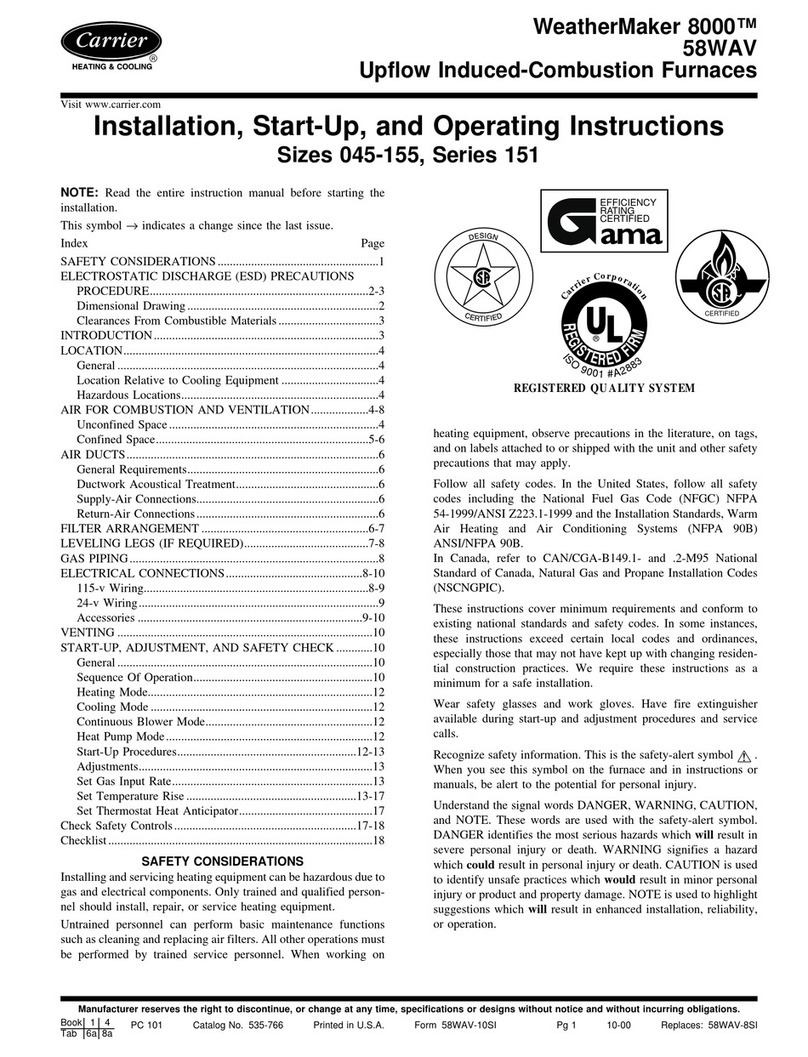
Carrier
Carrier WeatherMaker 8000 Installation, start-up, and operating instructions

Carrier
Carrier 58CLA Product data
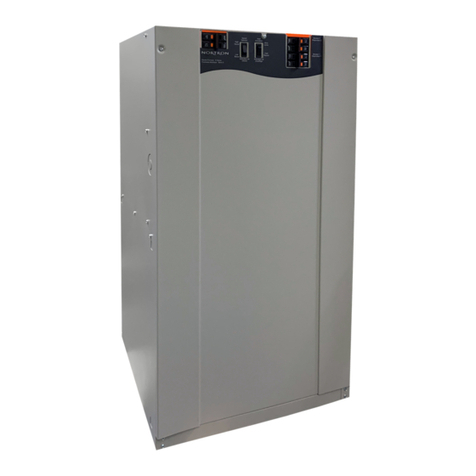
Nortron
Nortron D SERIES Installation and operating instructions
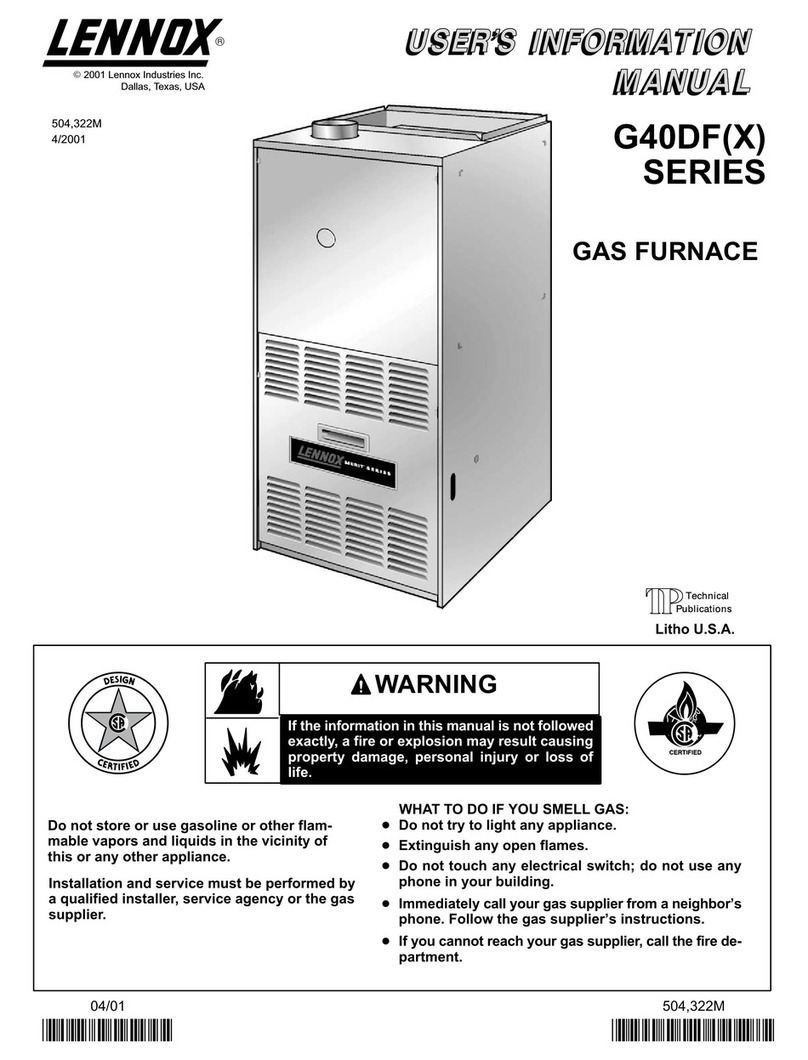
Lennox
Lennox G40DF Series User's information manual

TOKMET
TOKMET DENTAMATIC 500 HT Operation manual

Carrier
Carrier 58GA Installation, Start-Up and Service Instructions

